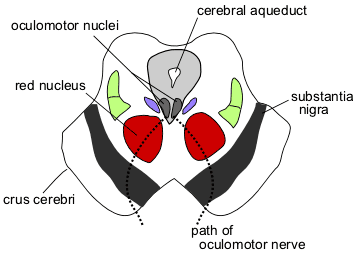Latin nucleus ruber NeuroLex ID Red nucleus TA A14.1.06.323 | NeuroNames hier-496 Dorlands/Elsevier n_11/12583247 | |
 | ||
MeSH A08.186.211.132.659.822.642 | ||
The red nucleus or nucleus ruber is a structure in the rostral midbrain involved in motor coordination. It is pale pink in color; the color is believed to be due to iron, which is present in the red nucleus in at least two different forms: hemoglobin and ferritin. It comprises a caudal magnocellular and a rostral parvocellular part. It is located in the tegmentum of the midbrain next to the substantia nigra. The red nucleus and substantia nigra are subcortical centers of the extrapyramidal motor system.
Contents
Function
In vertebrates without a significant corticospinal tract, gait is mainly controlled by the red nucleus.
However, where the corticospinal tract is dominant (as in primates), the rubrospinal tract may be considered to be vestigial. Therefore, here the red nucleus is less important in motor functions than in many other mammals. However, the crawling of babies is controlled by the red nucleus, as is arm swinging in typical walking. The red nucleus may play an additional role in controlling muscles of the shoulder and upper arm via projections of its magnocellular part. In humans, the red nucleus also has sparse control over hands, as the rubrospinal tract is more involved in large muscle movement such as that for arms (but not the legs, as the tract terminates in the superior thoracic region of the spinal cord). Fine control of the fingers is not modified by the functioning of the red nucleus (rather it relies on the corticospinal tract). The majority of red nucleus axons do not project to the spinal cord, but instead (via its parvocellular part) relay information from the motor cortex to the cerebellum through the inferior olivary complex, an important relay center in the medulla.
Input and output
The red nucleus receives many inputs from the cerebellum (interposed nucleus and the lateral cerebellar nucleus) of the opposite side and an input from the motor cortex of the same side.
The red nucleus has two sets of efferents:-
